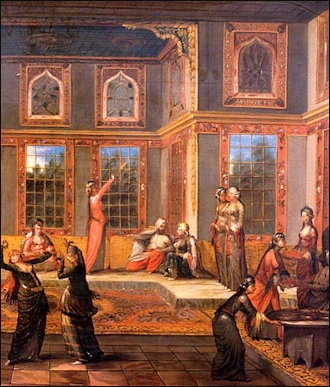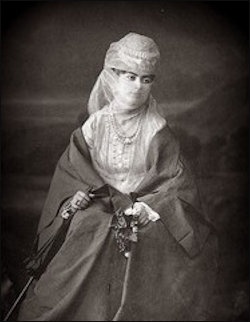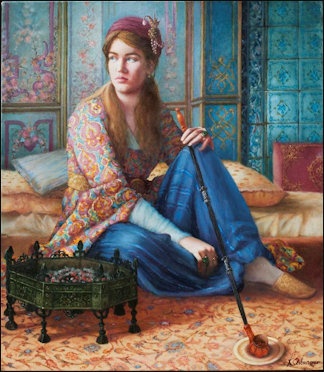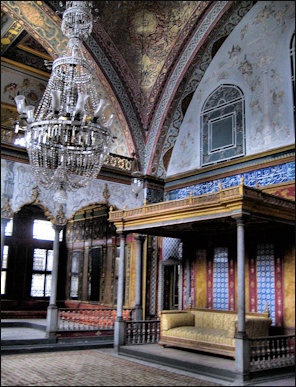TOPKAPI HAREM

Most Ottoman sultans married slaves. From the 16th century on no Ottoman sultan was married to a free woman.Turkish sultans were allowed four wives and as many concubines as they wanted. The Topkapi Harem (left of the second court, near the entrance gate) is contains the secluded quarters where the women lived, the chambers where they entertained the sultan and the swimming pool where they frolicked and swam laps. During Ottoman times the sultan was the only man who still retained his plumbing that was allowed to enter the Harem; uninvited guests sometimes ended up with the traitors at the front gate. The word “harem” is derived from Arabic word “harim,” which means “inviolable area.”
Expanded by Murat III in 1589 to 400 rooms, the harem in Topkapi it was the largest harem in the world, requiring a staff of 1,200 servants to keep it running smoothly. The complex included the sultan’s bedroom pavilions, quarters for the sultan’s mother, baths for the sultan and his mother, quarters for the princesses, dormitories for the girls and eunuchs, swimming-pool-like marble baths for the girls, latrines, a hospital, a domed salon, a dungeon and special rooms where the sultan's brothers were confined to keep them from hatching plots and conspiracies. The sultan and his ladies were entertained by troubadours and jesters in the grand audience hall, which was equipped with fountains to foil eavesdroppers.
The quarters for the sultan and his mother were quite grand. The bedroom of Murad II was a collection of room designed by the great architect Sinan. It contains Iznik tiles, a marble fountain and a plume-shaped bronze fireplace. The fountain was used to conceal the sound of voices. Accommodations for the wives, concubines, dwarfs and other retainers in the palace in many ways was more like a prison than a palace. Most people lived in dormitories. Those that lived alone lived in small misshapen rooms with no windows. As their importance to the sultan diminished so too did their room size.
Websites and Resources: Ottoman Empire and Turks: The Ottomans.org theottomans.org ; Ottoman Text Archive Project – University of Washington courses.washington.edu ; Wikipedia article on the Ottoman Empire Wikipedia ; Encyclopædia Britannica article on the Ottoman Empire britannica.com ; American Travelers to the Holy Land in the 19th Century Shapell Manuscript Foundation shapell.org/historical-perspectives/exhibitions ; Ottoman Empire and Turk Resources – University of Michigan umich.edu/~turkis ; Turkey in Asia, 1920 wdl.org ; Wikipedia article on the Turkish People Wikipedia ; Turkish Studies, Turkic republics, regions, and peoples at University of Michigan umich.edu/~turkish/turkic ; Türkçestan Orientaal's links to Turkic languages users.telenet.be/orientaal/turkcestan ; Turkish Culture Portal turkishculture.org ; ATON, the Uysal-Walker Archive of Turkish Oral Narrative at Texas Tech University aton.ttu.edu ; The Horse, the Wheel and Language, How Bronze-Age Riders from the Eurasian Steppes shaped the Modern World", David W Anthony, 2007 archive.org/details/horsewheelandlanguage ; Wikipedia article on Eurasian nomads Wikipedia
Members of the Sultan’s Harem
The harem was organized under a seniority system. The ruler of the harem was the sultan's mother, who often was the second most powerful person in the empire. At the bottom of the hierarchy were new girls who were often treated like slaves by the women who had been around for while. There was a lot of scheming and plotting inside the Harem, and the goal of every women was to produce the future sultan. Watching over them to make sure they didn't get too out of line were white and black Eunuchs from the Caucasus and the Sudan. Eunuchs that misbehaved were thumbscrewed, strung up by their wrists and beaten on their feet.

Fruit Room of the Topkapi harem
The word eunuch comes from the Greek word for bed watcher. Eunuchs were used in China, the Byzantine Empire, the Ottoman Turkey and many other places by monarchs as "keepers of the couch." "The eunuchs detailed to attend on the women of the harem" wrote Boorstin, were "no menace to the purity of the imperial line or to the chastity of the royal consorts...They became a privileged class. Knowledge of the daily habits and personal tastes of the emperor gave eunuchs a peculiar opportunity to anticipate the monarch's whims. [Source: "The Discoverers" by Daniel Boorstin]
The sultans had dozens of wives (only four of which were legitimate according to Muslim law) and hundred of concubines. Blonde women from the Caucasus were highly prized for their beauty and the sultan often traded many good horses to get his hands on one. These girls were not only skilled in pleasing the sultan in his private chambers they also entertained him with music and poetry. Those that became favorites wielded great influence. Those that had a son became even more powerful.
There are stories about how Murad III used to line up his concubines and drop a handkerchief at the foot of the one he selected for the night and how Selim II needed 18 eunuchs to look over his 150 concubines. Only a small number of the harem women were consorts of the sultan. Most were girls in their teens who were educated full time, before being promoted to serve the sultan or his family. Many were gifts by their families or were captured. Harem girls that fulfilled their service were free to leave with a pension or an arranged marriage.
Members of the harem that displeased the sultan, on the other hand, were sewn into weighted sacks and tossed into the Golden Horn. One enraged sultan reportedly tossed his entire harem, all 1001 members, into the sea off Seraglio point. People at the time had a hard believing it was true until a diver retrieving an anchor saw "an eerie underwater forest of sacks swaying in the current." In the 18th century the staff of the Harem was reduced by more conventional means, and when the last sultan Abdul Hamid II was deposed in 1909 the staff consisted of only 173 servants and 127 eunuchs.
Eunuchs

eunuch at the harem pool
According to the BBC: “Male slaves who had had their sexual organs removed were called eunuchs, and played an important part in some Muslim societies (as they did in some other cultures). They had the advantage for their masters of not being subject to sexual influence, and as they were unlikely to marry, they had no family ties to hinder their devotion to duty. [Source: BBC, September 7, 2009 |::|]
“Eunuch slavery involved compulsory mutilation, which usually took place between the ages of 8 and 12. Without modern medical skills and anaesthetics this was painful, and often led to fatal complications, and sometimes to physical or psychological problems for those who survived the operation. |::|
“Eunuchs had a particular role as guardians of the harem and were the main way in which the women of the harem had contact with the world outside. |::| In the Ottoman Empire eunuchs from Africa held considerable power from the mid sixteenth century to the eighteenth. It's recorded that the Ottoman family owned 194 eunuchs as late as 1903, of whom 35 'bore a title of some seniority'. Eunuchs could also play important military roles. |::|
Concubinage and Sexual Slavery in Muslim Societies
According to the Encyclopaedia of Islam: “Concubinage may be defined as the more or less permanent cohabitation (outside the marriage bond) of a man with a woman or women, whose position would be that of secondary wives, women bought, acquired by gift, captured in war, or domestic slaves.”
In the Ottoman Empire the sale of woman as slaves continued until 1908. The BBC says: “Muslim cultures are thought to have had more female slaves than male slaves. Enslaved women were given many tasks and one of the most common was working as a domestic servant. But some female slaves were forced to become sex workers: not prostitutes, as this is forbidden in Islam, but concubines. Concubines were women who were sexually available to their master, but not married to him. A Muslim man could have as many concubines as he could afford. [Source: BBC, September 7, 2009 |::|]
“Being a concubine did have some benefits: if a slave woman gave birth to her owner's child, her status improved dramatically - she could not be sold or given away, and when her owner died she became free. The child was also free and would inherit from their father as any other children. |::|
“Concubinage was not prostitution in the commercial sense both because that was explicitly forbidden and because only the owner could legitimately have sex with a female slave; anyone else who had sex with her was guilty of fornication. Concubinage was not unique to Islam; the Bible records that King Solomon and King David both had concubines, and it is recorded in other cultures too.” |::|
Harem Women

Harem women were essentially concubines who lived in the harem, an area of the household where women lived separately from men. According to Ehud R Toledano: 1) The harem system grew out of the need in Ottoman society to achieve gender segregation and limit women's accessibility to men who did not belong to their family. 2) Households were divided into two separate sections: the selamlik, housing the male members, and the haremlik, where the women and children dwelt. 3) At the head of the women's part reigned the master's mother or his first wife (out of a maximum of four wives allowed by Islam). [Source: Ehud R. Toledano, “Slavery and Abolition in the Ottoman Middle East, 1998,” the BBC |=|]
4) The concubines were also part of the harem, where all the attendants were women. Male guests of the master were not entertained in the harem. 5) An active and well-developed social network linked harems of similar status across Ottoman towns and villages; mutual visits and outdoor excursions were common. 6) For the women who actually spent their lives in the harems, reality was, of course, far more mixed and complicated. |=
7) The women who came into the harem as slaves (câriyes) were taught and trained to be "ladies," learning all the domestic and social roles attached to that position. As they grew up, they would be paired with the men of the family either as concubines or as legal wives. 8) However, harem slaves' freedom of choice was rather limited, as was that of women in general in an essentially male-dominated environment. Harem slaves frequently had to endure sexual harassment from male members of the family. |=
According to the BBC: “Writers disagree over the nature of concubinage and the harem: 1) Some argue that it was seriously wrong in that; 2) it was just slavery; 3) it breached human rights; 3) it exploited women; 4) women could be bought and sold, or given as gifts; 5) it involved compulsory non-consensual sex - which would nowadays be called 'rape'; 5) it reinforced male power in the culture; 6) Others say that it was relatively benign, because; 7) it gave female slaves a relatively easy existence; 8) it gave female slaves a chance to rise socially; 9) it gave female slaves a chance to gain power; 10) it gave female slaves a chance to gain their freedom. [Source: BBC, September 7, 2009 |::|]
“A balanced view might be to say that sexual slavery in this context was a very bad thing, but that it was possible for some of the more fortunate victims to gain benefits that provided some degree of compensation. |::|
Political Role of Concubines in the Ottoman Empire

Presumed portrait of Hürrem Kadınefendi, fourth wife of Sultan Ahmed III originally portrayed by an Venetian painter c.1715
Concubines sometimes played important political roles and wielded direct political influence government policy. Leslie P. Peirce wrote in “The Imperial Harem: Women and Sovereignty in the Ottoman Empire”: “More than any other Muslim dynasty, the Ottomans raised the practice of slave concubinage to a reproductive principle: after the generations of Osman and Orhan, virtually all offspring of the sultans appear to have been born of concubine mothers.” [Source: Leslie P. Peirce, “The Imperial Harem: Women and Sovereignty in the Ottoman Empire,” 1993]
According to the BBC: “The benefit to the state, or at least to the ruling dynasty, of having the ruling line born through concubines rather than wives was that only one family was involved - the family of a concubine was irrelevant, but the family of a wife would expect to gain power and influence through their relationship to the mother of the son. These conflicting interests could threaten the succession and weaken the ruling family. (This didn't eliminate conflict between heirs and families altogether, but it probably reduced it.) [Source: BBC, September 7, 2009 |::|]
“Concubines as well as wives also played an important role in strengthening cohesion, stability, and continuity at household level too, as this remark about 18th century Cairo demonstrates. Mary Ann Fay wrote: “Marital and nonmarital unions strengthened the links among men; women legitimized the succession of men to power, and women's property ownership added to the overall wealth, prestige, and power of a household. [Source: Mary Ann Fay, “From Concubines to Capitalists: Women, Property, and Power in Eighteenth-century Cairo,” Journal of Women's History, 1998]
“However, the harem was not a prison; it was instead the family quarters of an upper-class home which became exclusively female space when men not related to the women were in the house and whose entry into the harem was forbidden. Women, heavily veiled, could and did leave their homes...Women were not imprisoned in the harem or in the veils and cloaks that concealed their bodies and faces on the street, but both customs were important signifiers of women's lack of sexual autonomy and of men's control over the selection of women's sexual and marital partners. In the economic sphere, however, women had a great deal of autonomy... Therefore, the eighteenth-century Egyptian household should not be seen as the site of unrelieved oppression of women but rather in terms of asymmetries of power between men and women.”
Entering a Turkish Harem to Paint

Topkapi harem
Demetra Vaka wrote in Aïshé Hanoum (c. 1888):“The next morning, I had just finished my morning toilet when a slave came to conduct me to Aishe Hanoum, from whom she presented me with an indoor veil. I arranged it on my hair, to show my appreciation of the gift, and followed the slave to the floor below, where her mistress lived. [Source: Eva March Tappan, ed., The World's Story: A History of the World in Story, Song and Art, (Boston: Houghton Mifflin, 1914), Vol. VI: Russia, Austria-Hungary, The Balkan States, and Turkey, pp. 579-582]
“When I entered her apartments, I found her kneeling before an easel, deep in work. As the slave announced me, she rose from the ground and came to me with outstretched hand. It struck me as curious that she offered to shake hands, instead of using the temena, the Turkish form of salutation, since I knew her to be extremely punctilious in the customs of her nation. I suppose she did this to make me feel more at home. "Welcome, young hanoum," she said, after kissing me on both cheeks.
“"Do you paint?" I asked, going toward the easel, disguising my surprise at meeting with such disregard of Mussulman customs in this orthodox household. “No, not painting, just playing. It is only an impression, not a reproduction of one of Allah's realities." Good Mussulmans do not believe in "reproducing Allah's realities"; yet there stood on the easel a charming pastel. Even orthodox Moslems, I saw, were not above beating the devil round the stump. "How very beautiful!" I exclaimed. "Aishe Hanoum, you are an artist."
“"Pray! pray! young hanoum," she protested, a little frightened, I thought, "pray do not say such things. I am not an artist. I only play with the colors." "Let me see some more of your playing," I persisted. Rather reluctantly, though wishing to comply with her guest's desires, she brought out a large portfolio, containing several pastels and water-colors, and we sat down on a rug to examine them. Whether they were well done or not I cannot tell; but they were full of life and happiness. The curious part was that, whenever she painted any outdoor life, she painted it from her window, and on the canvas first was the window, and then through it you saw the landscape as she saw it.
“The more I looked at her work, the more enthusiastic I grew. "You must be very talented," I said, turning to her. "It is a pity that you cannot go abroad to study." "But I have studied many years here."
“"That is all very well," I said, still busy looking at the pictures. "Just the same you ought to go to Paris to study." "What for?" she asked. "Because I think you have a great deal of talent which unfortunately is wasted in a harem." As I spoke, I raised my eyes.
“Ordinarily I am not a coward, though I do run from a mouse; but when my eyes met her finely penciled ones, there was a curious look of anger in them that made a shiver go down my back. "If I have said anything to offend you," I said, "I beg you to forgive me. Believe me, it was my enthusiasm." She smiled in a most charming way. If she had been angry, it had gone quickly by. "But why do you wish me to go to Paris?" she asked again.
“"I don't know," I said, "except that Paris is nearer Turkey than any other great center, and I feel that you ought to have the advantage of being where you could get all the help possible." "What for?" she inquired. I began to feel uncomfortable. I knew her very little, and this was the first time I ever visited a former seraigli (one who has been an inmate of the imperial palace). "Because," I answered lamely, "when a person has talent she generally goes to Paris or to some other great artistic center." "What for?" again insisted the question.
“If I had not been in a harem, and in the presence of a woman of whom I was somewhat afraid, my answer would have been, "Well, if you are foolish enough not to know, why, what is the use of telling you? “Instead, while that exquisite hand was lying on my arm and those big almond-shaped eyes were holding mine, I tried to find a way of explaining. "If you were free to go, you could see masterpieces, you could study various methods of painting, and if it were in you, you might become great in turn." "What for?" was the calm inquiry.

harem women feeding pigeons in a courtyard
Encounter with Circassian Beauty in a Turkish Harem
Demetra Vaka wrote in Aïshé Hanoum (c. 1888): “She was very beautiful; not of the Turkish type, but of the pure Circassian, with exquisite lines and a very low, musical voice, and of all things on this earth I am most susceptible to physical beauty. At that particular moment, however, I should have derived great pleasure if I could have smacked her pretty mouth. "Well," I said calmly, though I was irritated, "if you had a great talent and became very famous, you would not only have all the money you wanted, but glory and admiration." "What for?" she repeated, with inhuman monotony. [Source: Eva March Tappan, ed., The World's Story: A History of the World in Story, Song and Art, (Boston: Houghton Mifflin, 1914), Vol. VI: Russia, Austria-Hungary, The Balkan States, and Turkey, pp. 579-582]
“"For Heaven's sake, Aishe Hanoum," I cried, "I don't know what for; but if I could, I should like to become famous and have glory and lots of money. “"What for?" "Because then I could go all over the world and see everything that is to be seen, and meet all sorts of interesting people." "What for?"
“"Hanoum doudou," I cried, lapsing into the Turkish I had spoken as a child. "Are you trying to make a fool of me, or—" She put her palms forward on the floor, and then her head went down and she laughed immoderately. I laughed, too, considerably relieved to have done with her "what for 's." She drew me to her as if I were a baby, and took me on her lap. "You would do all these things and travel about like a mail-bag because you think it would make you happy, don't you, yavroum?" she asked. "Of course, I should be happy." "Is this why you ran away from home—to get famous and rich?"
“She was speaking to me precisely as if I were a little bit of a thing, and was to be coaxed out of my foolishness. "I have neither fame nor riches," I answered, "so we need not waste our breath." "Sorry, yavroum, sorry," she said sympathetically. "I should have liked you to get both; then you would see that it would not have made you happy. Happiness is not acquired from satisfied desires." "What is happiness, then?" I asked. "Allah kerim [God only can explain it]. But it comes not from what we possess, but from what we let others possess; and no amount of fame would have made me leave my home and go among alien people to learn their ways of doing something which I take great pleasure in doing in my own way." She kissed me twice on the cheek and put me down by her. "You are a dear little one," she said.

Plan of the Harem of Topkapı Palace: 1) The Gate of Carriages and the Haremeyn Treasury/The Dome with Cupboards. 2) The Sofa with a Fountain - The Tower of Justice - The mosque of Harem Eunuchs. 3) The Courtyard and dormitories of the Harem eunuchs - The Chief Harem Eunuch's Quarters and the School of Princes - The Door of the Aviary (Harem Exit). 4) The main gate of the Harem and sentry post. 5) The Courtyard of the Queen Mother - The quarters of the Queen Mother, the Sultan's Consorts, the princes, the senior maid, the superintendent and of the servants. 6) The Passage and Courtyard of the Concubines - The quarters of the consorts of the Sultan - Dormitories and baths. 7) The Queen Mother's Quarters 8) Baths - Bath of the Sultan and of the Queen Mother. The Sultan's Private Apartments: 9) The Imperial Hall - The apartments of Abdühamid I, Selim III and Osman III. 10) Hall with a Fountain - the hall with a fireplace. 11) Privy Chamber of Murad III - The Privy Chambers of Ahmed I and Ahmed III (the Dining Room/Fruit Room) 12) The Twin Kiosks (the apartments of the crown prince) 13) The Terrace and Apartments of the Favourites/Anteroom between men's and women's quarters. 14) The Golden Road/Passage.
Image Sources: Wikimedia Commons
Text Sources: Internet Islamic History Sourcebook: sourcebooks.fordham.edu “World Religions” edited by Geoffrey Parrinder (Facts on File Publications, New York); “ Arab News, Jeddah; “Islam, a Short History “ by Karen Armstrong; “A History of the Arab Peoples “ by Albert Hourani (Faber and Faber, 1991); “Encyclopedia of the World Cultures “ edited by David Levinson (G.K. Hall & Company, New York, 1994). “ Encyclopedia of the World’s Religions” edited by R.C. Zaehner (Barnes & Noble Books, 1959); Metropolitan Museum of Art metmuseum.org National Geographic, BBC, New York Times, Washington Post, Los Angeles Times, Smithsonian magazine, The Guardian, BBC, Al Jazeera, Times of London, The New Yorker, Time, Newsweek, Reuters, Associated Press, AFP, Lonely Planet Guides, Library of Congress, Compton’s Encyclopedia and various books and other publications.
Last updated September 2018
